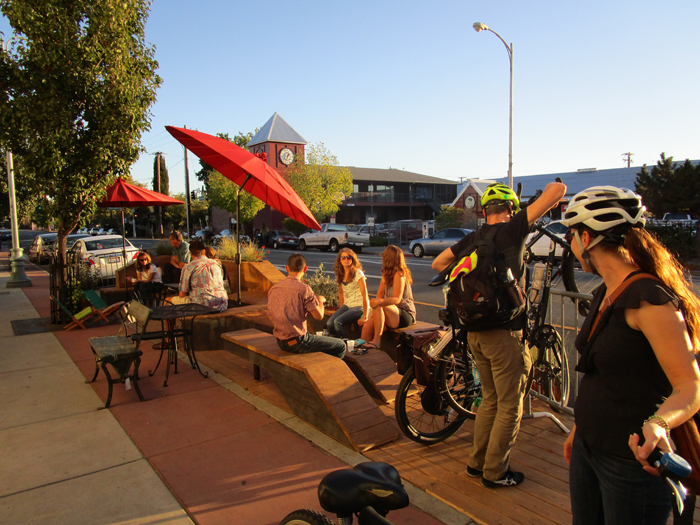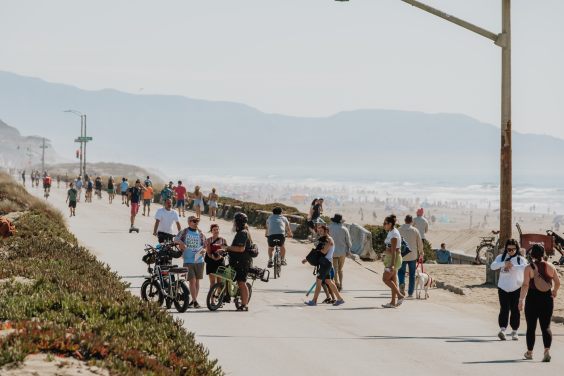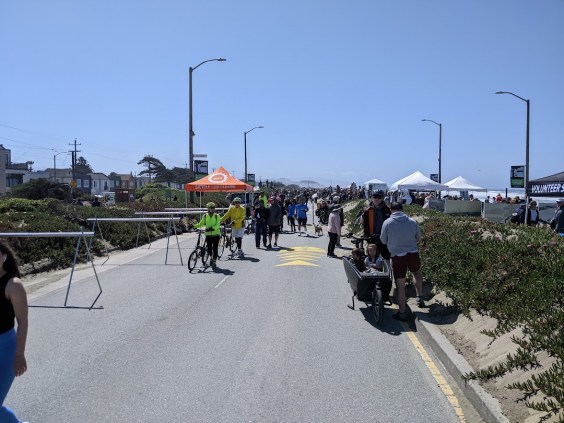Note: GJEL Accident Attorneys regularly sponsors coverage on Streetsblog San Francisco and Streetsblog California. Unless noted in the story, GJEL Accident Attorneys is not consulted for the content or editorial direction of the sponsored content.
Caltrans has finally released guidance for issuing permits to parklets built on state highways [PDF].
There has been only one parklet on a state highway--one official one, that is--in California, and that parklet is why this guidance now exists. There may have been the desire to build others, but the idea would have gone no further than the realization that the road is controlled by Caltrans. Planners just assumed the answer would be no.
Which it would have been, until now. Anne Thomas, director of Shasta Living Streets and the force behind that one official pilot parklet--it was in Redding, in 2015--told Streetsblog that, to get the pilot parklet she wanted, she had to sign an agreement not to try again until Caltrans had completed this guidance document.
Now, four years later, here it is. Caltrans can now issue permits to build parklets on state highways-- under certain circumstances. For example, on highways with speed limits of 30 mph or lower. And not at corners, where they can impede sight distance. And the permits have to be applied for, and the parklets built, by local agencies, not businesses or other organizations. And they must be open to the public. And the permits need to be renewed annually with Caltrans. They can't have lights or reflective surfaces. And any plantings can't have thorns (there are other requirements too--see this PDF).
"We were getting requests from cities and counties for parklets on conventional highways in downtowns," said James Anderson, Chief of the Office of Encroachment Permits at Caltrans. "They want to create more of a community environment where you can bike and scooter, you could sit down and read a book, I don't know. We created this guidance so Caltrans districts know how to process permits for these."
The guidance is specifically for Caltrans district offices, so they can let interested agencies know what is needed to apply for a permit. "We are not designing facilities, or telling them how to design it," said Anderson. "Every community is different, and we want to give municipalities a guide to our requirements for their proposals."
Parklets can radically change the feel of a street, and help reclaim public space for people, rather than cars. They came out of an idea floated by Rebar for Park(ing) Day that there were better things to do with street space than store cars, and have contributed to the ongoing cultural conversation about what public space ought to be used for, and who has the right to use it. While Redding's parklet was by far not the first one to be built in California, the fact that it was built on a state highway makes it very unusual.
"We did it originally because we wanted to elevate the thinking about the transportation plan, which was happening around the same time," said Thomas of Shasta Living Streets. "Redding was deciding whether to open up a nearby pedestrian mall, and we wanted to inspire ideas for making downtown Redding a bikeable, walkable city, and create a place for people to provide input for the plan."
The creation of that first pilot wouldn't have happened without huge support from then-District 2 Director Dave Moore, who championed the idea within Caltrans. "It broke all the rules--it was a standing object on a highway," said Thomas. "I don't know what they had to do to get permission. Our local office had a lot of conversations about how this was any different from a parked car on the highway."
Meanwhile Caltrans headquarters was working on revising its mission and adding goals to support other road users than just car drivers, and there was support there for exploring the idea. So somehow they were able to get permission for a three-day pilot.
It was a lot of work, and Shasta Living Streets lost money on it. A team of volunteers spent weeks building the parklet inside a warehouse, then cut it in pieces to install it quickly on the day the permit was valid.
It was wildly successful. Thousands of people came by to check it out, and local business owners were thrilled with the number of people stopping by. They came to Thomas and said they wanted to do it again, at Christmastime.
Thomas was more than a little burned out, and also pretty sure that Caltrans would say no. But at the highest level of Caltrans, she said, there was interest. "So they approved it as a test. They said it had to be for a longer time--ten days--and then that would be it until the guidelines were complete."
Last spring Redding approved its own local parklet policy for roads that are not controlled by Caltrans. Thomas said Shasta Living Streets had plans to do a permanent parklet on a nearby city street last summer, but then the Carr fire happened, and everything is on hold.
"We need to raise money for the materials to build the parklet," said Thomas, "but ever since the fire, nonprofits are struggling. Donations are way down, because everything is--understandably-- going to fire victims."






